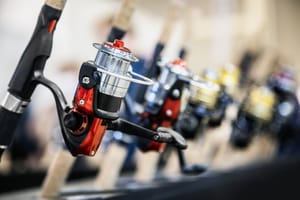Fishing is an art that combines skill, patience, and the right equipment. One crucial component that often goes unnoticed by beginners but is well-regarded by seasoned anglers is the fishing line leader. Understanding the role and importance of a leader can significantly enhance your fishing experience.
Key Takeaways:
- Learn what a fishing line leader is and its critical role in angling.
- Discover the different types of leaders and when to use each.
- Gain practical tips on selecting and using the right leader for your fishing needs.
Understanding the Fishing Line Leader
A fishing line leader is a short strand of material tied between the main fishing line and the lure or hook. Its primary purpose is to provide a clear, less visible connection to the fish, preventing them from being spooked by the line. Leaders are also designed to withstand the sharp teeth of certain fish species and the abrasive environments where they live, such as rocky bottoms or coral reefs.
Leaders come in various lengths, strengths, and materials, each suited to specific fishing conditions and target species. For example, a short, heavy leader might be used for trolling in saltwater to catch large, toothy fish, while a long, light leader could be ideal for fly fishing in clear streams where fish are line-shy.
Types of Fishing Line Leaders
There are two main types of leaders: monofilament and fluorocarbon. Monofilament leaders are made from a single strand of material and are known for their flexibility and stretch, which can be advantageous when fighting a fish. They are also less expensive than their fluorocarbon counterparts. However, monofilament is more visible underwater and can be more easily damaged by UV light and abrasion.
Fluorocarbon leaders, on the other hand, are valued for their near invisibility underwater due to their light refraction index being close to that of water. They are also more resistant to abrasion and have less stretch, providing better sensitivity and hook-setting power. Although more costly, fluorocarbon leaders are often preferred for their durability and discreet presentation.
Selecting the Right Leader
Choosing the right leader depends on several factors, including the fishing technique, target species, and water conditions. For instance, when targeting toothy fish like pike or barracuda, a thick, abrasion-resistant leader is essential to prevent the fish from biting through the line. In clear water conditions where fish are more likely to be spooked by the sight of a line, a thin, clear fluorocarbon leader would be the best choice.
The strength of the leader, known as the "test," should also match the size of the fish you're targeting. A heavier test is necessary for larger fish, while a lighter test can be used for smaller species. It's important to balance the strength of the leader with its visibility, as a leader that's too heavy can deter fish.
Practical Tips for Using Leaders
When tying a leader to your main line, it's crucial to use the appropriate knot for the type of line you're using. For example, the improved clinch knot is a popular choice for tying a monofilament leader, while the double uni knot is effective for connecting lines of different materials or diameters.
It's also essential to regularly check your leader for nicks, frays, or other signs of wear. A damaged leader can weaken and break when you hook a fish, resulting in a lost catch. Replacing your leader after catching a fish or after it has come into contact with abrasive surfaces can help maintain its integrity.
The Role of Leaders in Different Fishing Techniques
Leaders play a significant role in various fishing techniques. In fly fishing, a tapered leader is often used to ensure a smooth and natural presentation of the fly. The tapering from a thick butt section to a thin tippet allows the energy from the cast to transfer efficiently, laying the fly out straight.
In trolling, a leader serves as a shock absorber to handle the sudden strikes from fast-moving fish. A longer leader can also keep the lure or bait at a distance from the colored main line, which might otherwise alert the fish. Understanding the specific demands of each fishing technique will guide you in selecting the appropriate leader.
Summary
A fishing line leader is an indispensable tool for anglers looking to improve their catch rate. It serves as a discreet connection between the main line and the lure, providing both stealth and protection against breakage. Whether you choose monofilament or fluorocarbon, the right leader can make all the difference in your fishing success. Remember to consider the fishing environment, target species, and technique when selecting your leader, and always inspect it for wear and tear. With these insights, you're well on your way to becoming a more effective angler. Looking for a spinning reel for walleye? Check out our top 5 for 2024!
FAQ Section
Q: Why do I need a fishing line leader? A: A fishing line leader is necessary to prevent fish from being spooked by the main line, to protect against sharp teeth and abrasive environments, and to provide a more natural presentation of the lure or bait.
Q: How do I choose the right leader material? A: The choice between monofilament and fluorocarbon leaders depends on factors like water clarity, target species, and budget. Monofilament is more flexible and cost-effective, while fluorocarbon is less visible underwater and more abrasion-resistant.
Q: How often should I replace my fishing line leader? A: You should replace your leader whenever it shows signs of wear, such as nicks or frays, or after landing a fish. Regular inspection and maintenance will ensure your leader remains strong and reliable.



